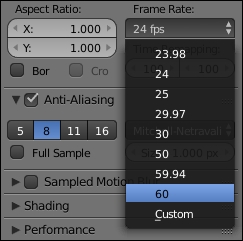Animating characters
Before we start animating our game characters, we need to set an important setting. Go to the Render tab in the Properties panel and find the Frame Rate option. Change the frame rate to 60 fps because that's what video games are running at. If you chose another option instead, your animation will seem like it is being played at a very slow speed in the game engine. So, make sure that this option is set before you start animating your character because prevention is better than cure.

Game animation has adopted a technique from traditional animation named key-framing. Key-framing is the process of assigning a posture or specific parameter (such as position, rotation, and scale) to a character or object at a specific point in time. Each of these key-frames is then processed by the computer to generate the in-between frames through a process named interpolation. This eliminates the need to animate every single frame, which is a very tedious job.
There are several ways you...























































